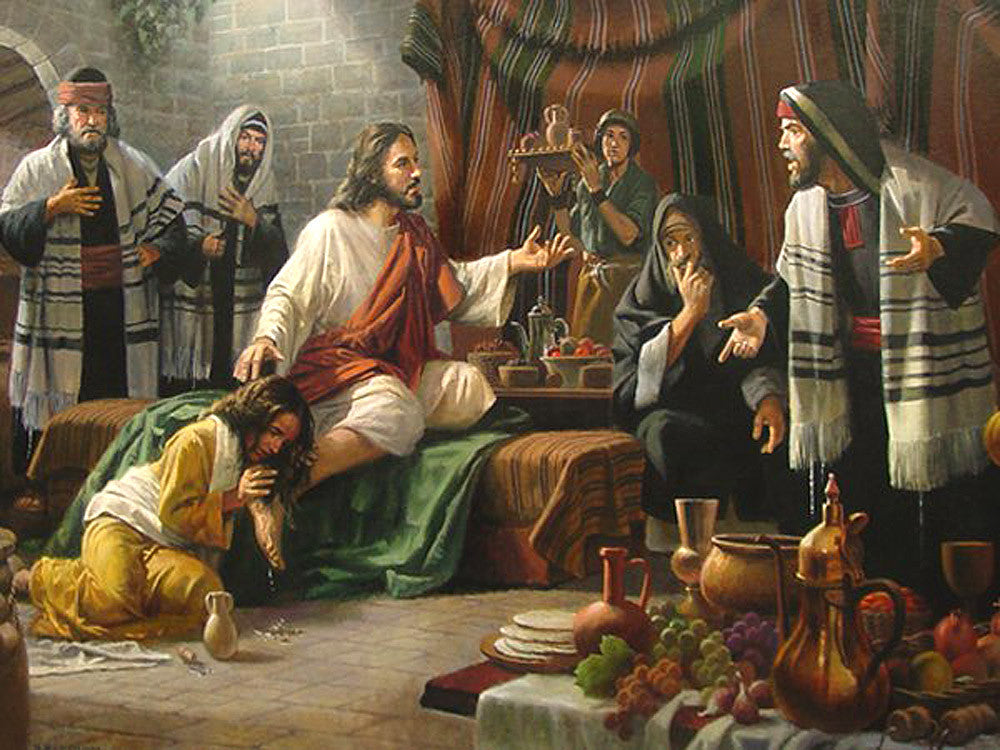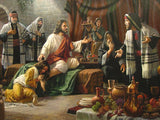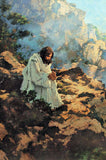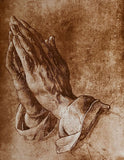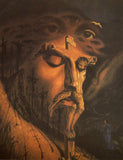Who Will Love Him More? by James Seward - Detail
Luke 7:36-50: Simon, a Pharisee, has invited Jesus to come and eat with him. As they ate a woman came in with an alabaster container of ointment. Weeping, she washed his feet with the ointment. Simon and his friends were amazed that this woman, noted as a sinner, would come in and do such an extravagant thing.
Jesus, being aware of Simon's derogatory attitude, spoke to him in a parable of a creditor which had two debtors, one owing 500 pence and the other 5 pence. The creditor forgave them both. Which of them will love him (the creditor) most Simon answered, To whom he forgave the most. Jesus replied, You have rightly judged.
Jesus admonished Simon for his lack of love. He had not washed His feet, had given Him no kiss. This woman showed her love of Jesus by her tears, kissing His feet and anointing. The final point was that she loved Him very much. Though her sins were many, Jesus said, Your sins are forgiven. My own comment: Do you see the tremendous grace and love of God
Simon, a Pharisee, was probably a rather wealthy man, with servants and many acquisitions for living comfortably. The scene takes place in his courtyard, and open area surrounded by rooms, sometimes with a roof, sometimes left open. According to the wealth of the owner, the courtyard was used for animals, baking, as a work area, and for other household activities. The wealthier owner used the space for entertainment and meals.
In this painting, a meal was served with a certain amount of elegance. The tables were usually U-shaped with couches around the table. The servants could move into the opening of the U to serve the guests. Guests would lie on the couches and lean on the elbows using their fingers to serve themselves.
Pictured in the painting are four water jugs that you would find in a Jewish home. I went to an exhibition of archeological finds in the Maltz Jewish Museum in Beachwood and saw these magnificent jars and containers for food. Each held about 20 gallons of water or wine and were about 36 inches tall. No photography was allowed so I made drawings of them and bought a small book depicting the jars, plus other articles and vessels of Biblical times. I also went to a Jewish religious store and bought a prayer shawl, called a tallis, for my models to wear for the painting. The lady posing for the woman is Jewish and was quite familiar with the story. She has posed for me for other paintings.
In doing these religious paintings, I try to do as much research as possible. I look at the paintings of the Orientalists that were done in the 1700 and 1800s. Tissot, who spent most of his time painting for a Douay version of the Bible, painted in the 1800s. His works were as close as I can find for accuracy of the area and clothing, etc., before modern times took over in Israel. Regardless of looking at these other artists' works, I rely on museums as much as I can.
In addition to trying to be as accurate as possible, I hope my work depicts the tremendous love and grace of our precious Lord and Savior, Jesus Christ. - James E. Seward


